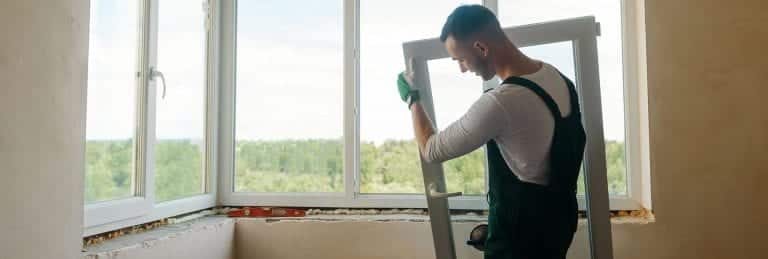Guide on When to Replace Windows

You’ve lived happily in your home for ten years—but suddenly, it feels much draftier than you recall from past winters. Or perhaps you suddenly hear noise from outside when the neighborhood previously seemed so quiet. Or maybe your energy bills have suddenly skyrocketed even though your usage has remained the same.
All of these problems are typical signs that something is awry with your windows.
As a homeowner, your goal is always to minimize your repair spending while maximizing the value of your home. So how do you know whether to go for a window repair or window replacement? In this guide, we’ll cover the most common window-related problems and explain your options for improving your comfort and reducing your energy consumption. Let’s begin!
Addressing Windowpane and Frame Damage
Throughout their lifetime, your windows face a variety of threats, from serious storms to stray baseballs.
To keep your windows functioning properly, you’ll periodically need to perform maintenance and repairs.
Minor issues that you can typically have fixed include:
- Window sashes that stick – Having trouble opening an antique or recently painted window? A professional can likely help repair the sash, the part of the window that helps it glide.
- Drafty windows – Adding weatherstrips or caulking can potentially help reduce drafts without necessitating a new window.
- Damaged window casing – If one of the elements of your window’s frame is damaged, it may be possible to disassemble the window and replace the offending part.
- Broken or cracked glass – It’s relatively straightforward to replace a few panes of glass.
Before repairing, compare the cost of your proposed upgrade to the cost of replacement. If you plan to replace your windows in the near term anyway to enjoy benefits such as increased energy efficiency, it might make sense to go ahead and invest in new windows now.
When Repairs Won’t Cut it
Sometimes, repair simply isn’t an option for the “minor” issues noted above.
For example, if you’re having persistent difficulty opening or closing your windows, there might be a problem with the entire frame. While sash issues are often the culprit behind sticky windows, it’s also possible that your entire frame has expanded. Certain materials like aluminum or vinyl can degrade over time, impacting the window frame’s function, while wood can well.
In these cases, replacing your affected windows is the correct choice, as repairs won’t properly deal with the extent of the problem.
Next, we’ll take a closer look at some other specific situations that necessitate expertise beyond your average handyman’s training.
Dealing with Water Damage
A little bit of water on the inside of the window can be fixable with caulking, but more moisture signals a bigger problem. When you start seeing puddles on the floor after it rains, your windows are failing in a way that will be hard to repair.
If your wooden window frame is retaining moisture, it could cause serious issues such as rot. This problem happens when fungi on the wood frame begin to feed on the accumulated moisture and eat away at the wood of your windowsill.
The problem soon compounds:
- Rot spreads – Once there’s rot in your existing window, it can spread to the rest of the frame or even the surrounding walls.
- The frame decomposes – Eventually, your frame will start to fall apart. At this point, it won’t form a seal, which means your window won’t keep in heat or AC.
- Mold can grow – Damp, rotting wood is the perfect environment for mold and mildew, which pose hazards to your family’s health.
But how do you know if it’s already too late? What if rot has set in? Is it something you would be able to notice, even through a coat of paint? The good news is that it’s easy to check for a rotting window frame. Look out for:
- Discolored paint spots
- Wood that feels soft to the touch
- Wood that breaks easily with slight pressure applied
If you see any of these signs, your wooden frame is damaged, and you need to replace the damaged window before the problem worsens. You might be tempted to learn how to replace the wood around the window yourself. However, this undertaking might not only damage the window, but also the surrounding structure’s integrity. So think wisely before taking on any repair work yourself.
Clearing Up Your Constantly Foggy Windows
Foggy windows aren’t a big deal in your car—you can simply turn on the defogger.
The same isn’t true in your home. One of the best way to clean a glass window that’s foggy is using a baking soda and vinegar solution. However, if your windows look fogged up even after a thorough cleaning, it means condensation has gotten into the window itself.
This problem occurs with double- or triple-paned windows built with multiple sheets of insulated glass. If the window seal fails, moisture can get in between these panes of glass, causing your windows to take on a permanently foggy look.
And the loss of view isn’t the only issue caused by foggy glass. You’ll also have trouble with:
- Window insulation – When condensation gets between the panes of insulated glass, it reduces their ability to do their job and regulate temperature.
- Energy efficiency – As a result of the reduced insulation, your house won’t trap the heat in the winter or the AC in the summer as well.
Eventually, the reduced insulation and energy efficiency will drive up your energy bill as you’ll need to run the heat and the AC more often to keep your house at a comfortable temperature.
How to Fix Fogged Glass
Most of the time, a foggy window necessitates a replacement. Unfortunately, because of how today’s insulated glass unit (IGU) windows are made, you can’t just have someone dismantle the window and wipe the glass panes to remove the condensation. This means that usually, when your glass fogs, you’ll need to get a new window.
However, some companies have developed a new technique to remove the condensation from the glass, which allows the window to be repaired rather than replaced. This unique process involves:
- Drilling minuscule holes into the glass
- Using a cleaning solution between the panes
- Venting and drying the window
The best methods to do so also make sure the condensation has been removed permanently, restore your window’s insulating value, and are much cheaper than getting a window replacement.
Embracing Eco-consciousness and Sustainability
While a short-term fix might seem like the most economical option, upgrading any older window now can have future benefits for your budget and might even increase your home’s curb appeal. But there are so many window replacement options to choose from that it can be hard to pick the right one.
New Energy Star certified windows are more sustainable than older models. Companies design them to better trap AC and heat in your home, meaning you need to use less energy to keep it at a stable temperature—which means lower energy bills. The design of New Energy Star windows makes them one of the most energy-efficient windows.
Next, we’ll take a closer look at the benefits of these upgrades.
What is Energy Star?
Energy Star is a label that the U.S. government regulates to signify a certain standard of energy efficiency. Any product bearing this certification must meet standards set by the Environmental Protection Agency (EPA). The criteria a product needs to fulfill are different depending on what it is—a light bulb has different efficiency standards than a refrigerator.
But since all Energy Star products are more efficient than their standard counterparts, they lessen the amount of waste and pollution caused while potentially lowering energy costs and increasing the value of your home.
Energy Star windows have had significant sustainable benefits, including:
- Saving five trillion kilowatt-hours worth of electricity since their inception in 1992
- Avoiding $39 billion of energy use in 2019 alone
- Preventing roughly four billion metric tons of greenhouse gas emissions
As a significant bonus, your energy-efficient windows can come with financial benefits:
- In some cases, you might be eligible for local or federal tax credits for upgrading your home’s energy efficiency. Talk with your contractor to understand the specific perks that come with your prospective new windows.
- Your windows will lower your average monthly heating and cooling costs, thus paying for themselves over time.
- If you’re planning to refinance or sell your home, investing in energy-efficient upgrades can boost the appraised value, potentially helping you build equity that you can benefit from in the future.
Find the Trusted Local Professionals With the Glass Guru
To repair or replace? For homeowners, this is a perennial question. To answer it, the first step is always finding a reliable contractor who can give you an honest assessment of your windows’ longevity while clearly explaining your options for repair and replacement.
The Glass Guru comprises a network of local home and business owners who know what it’s like to go through the aggravation of finding a contractor you can trust. Our contractors will always explain your options for repair before moving on to a replacement. And if replacement windows are necessary, we’ll make sure that you can get top products at a price you can afford.
Whether your problem is fogging, moisture, or hail damage, our capable team of local employees can help you solve it. Aside from windows, we can also recommend you to a contractor that can clean and repair different types of glass partitions. Whatever glass repair you need, we have a contractor in mind. This way, you can get back to enjoying the home you’ve built. So get your free estimate from us today! Our top priority is making sure that you get the exemplary work done in a way that improves the value of your home.
Sources:
- NACHI. Wood Decay. https://www.nachi.org/wood-decay.htm
- The Spruce. Should You Repair or Replace Your Windows? https://www.thespruce.com/windows-replaced-rather-than-repaired-1822905
- Energy Star. About Energy Star. https://www.energystar.gov/about
- Energy Star. Federal tax credits. https://www.energystar.gov/about/federal_tax_credits







